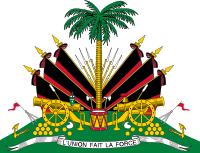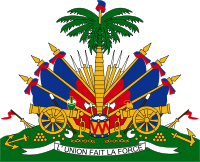- Coat of arms of Haiti
-
 Coat of arms from the Duvalier era. The only notable differences are the design of the flags, accompanying the change of the national flag during the time, and the omission of the Phrygian cap.
Coat of arms from the Duvalier era. The only notable differences are the design of the flags, accompanying the change of the national flag during the time, and the omission of the Phrygian cap.
The coat of arms of Haiti was first introduced in 1807, and has appeared in its current form since 1986.
It shows six draped flags of the country, three on each side, which are located before a palm tree and cannons on a green lawn. On the lawn various items are found, such as a drum, a bugle, long guns, and ship anchors. Above the palm tree, there is a Phrygian cap placed as a symbol of freedom. On the lawn between the drum and the ribbon there were supposed to be two pieces of chain with a broken link symbolizing the broken chain of slavery.[citation needed]
The ribbon bears the national motto of Haiti: L'Union Fait La Force (French, "Unity Is Strength").
The oldest use of a symbol for Haiti is known since 1807. The symbol shows several national flags, with two cannons and palm trees. The symbol indicates the battle for independence of the republic. The motto, in French, means 'Strength through unity'. The symbol remained in use until 1849, when President General Faustin Soulouque crowned himself as Emperor Faustin I. At the same time he adopted new Imperial arms, showing two cannons and a (French) imperial eagle. Two lions were used as supporter and the whole placed in a purple mantle. The emperor was forced to leave the country in 1859, after which the old symbol was restored. Ever since the composition has been the same, but the colors and items have changed somewhat.[1]
Notes
Sovereign states Dependencies and
other territories- Anguilla
- Aruba
- Bermuda
- Bonaire
- British Virgin Islands
- Cayman Islands
- Curaçao
- Greenland
- Guadeloupe
- Martinique
- Montserrat
- Navassa Island
- Puerto Rico
- Saint Barthélemy
- Saint Martin
- Saint Pierre and Miquelon
- Saba
- Sint Eustatius
- Sint Maarten
- Turks and Caicos Islands
- United States Virgin Islands
Categories:- National symbols of Haiti
- National coats of arms
Wikimedia Foundation. 2010.

